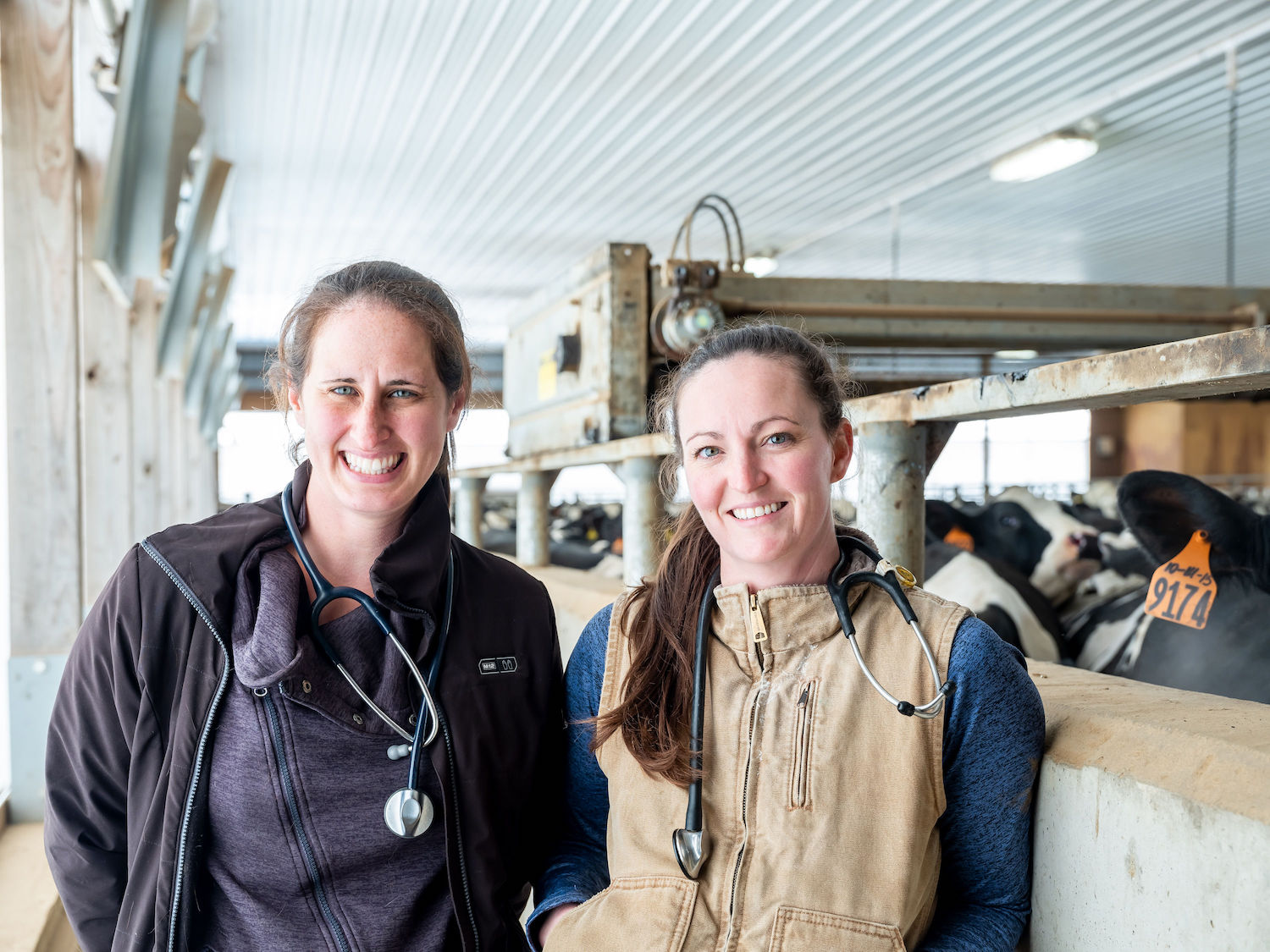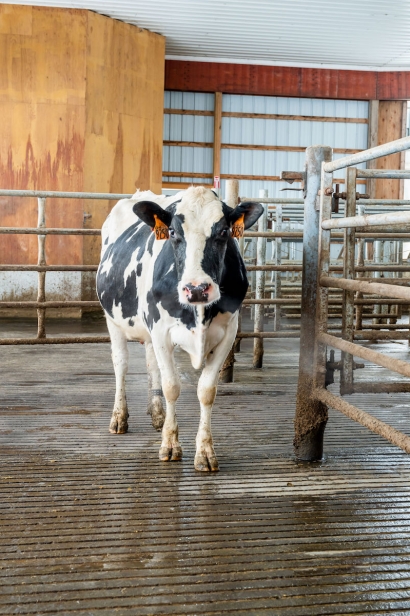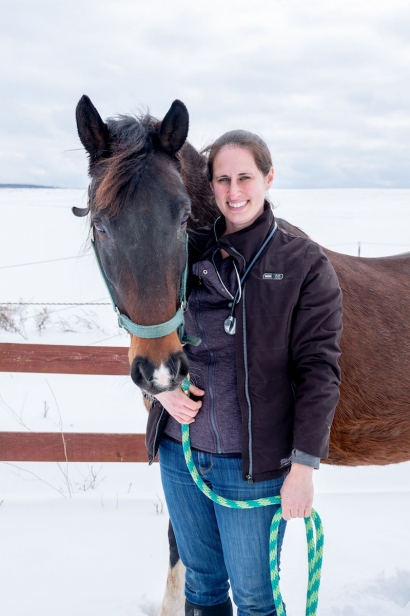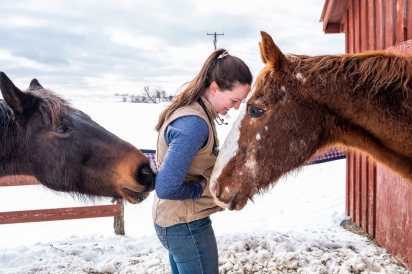River Valley Veterinary Services
If you have a dog or cat, you have the pick of the litter in terms of veterinarians. But large animal vets are a dying breed.
The growing shortage of food animal veterinarians in the U.S. is becoming so dire, the American Veterinary Medical Association declared a “crisis” in the industry in 2017. Between 1990 and 2007, the number of large animal vets plummeted by a third. Currently, only 1.8% of practicing vets with private practices exclusively work with so-called “food animals.” An additional 4.5% of the 71,393 practicing private vets work “predominantly” with “food animals.” Almost 67%, meanwhile, work exclusively with “companion animals.”
U.S. Department of Agriculture’s National Institute of Food and Agriculture (NIFA) has declared that 187 areas across the country have “inadequate access to livestock and public health veterinarians.” NIFA is offering loan repayments (up to $75,000) and all manner of other perks to recruit new blood. Current areas of New York in crisis are Chautauqua, Western Cattaraugus and Otsego, but we’ve heard rumbles that the shortage is underreported and that many large animal vets are spreading themselves too far and wide for their own—or the animals they serve—good.
For farmers whose work depends on animals, a good vet can be the difference, in some cases between just getting by and thriving, and in others, life and death. One farmer we interviewed for this issue attributed much of the success of their cheese business to their vet.
As Lee Hennesy pointed out, goats that aren’t happy and healthy won’t produce milk. And without milk, there will be no cheese. And without cheese … well, we’ve all seen the American Farmland Trust bumper stickers, “No Farms, No Food.” But without people caring for the animals who feed us, there will be no farms.
Between “healthy calf” calls, downed animal emergencies and herd checks, we pinned down the founding veterinarians behind Mohawk Valley’s River Valley Veterinary Services, Dr. Jill Greisman and Dr. Jessie Bolster, to discuss their love of their work, and their hopes and fears for its future.
Edible Capital District: Did you grow up reading the idyllic vision of veterinarian life in children’s books like All Creatures Great and Small by James Herriot?
Dr. Jill: I grew up in a household in Manhattan where mom was allergic to all animals with hair. I didn’t even consider becoming a vet until I was in high school, and I started toying with the idea. My parents, my grandfather and now my sister are all humans-doctors, and I saw that as my path as well. When I was in college at Cornell, I fell in love with the countryside and came to prefer it much more so than the city. It all came together at Cornell: I learned not only was I better suited to being an animal doctor, I also wanted to settle in a rural area.
Dr. Jessie: I’m opposite. I’ve known I’ve wanted to a vet since I was four years old. My grandfather was very much a James Herriot–like character, just the small town version. Growing up in Georgia, I heard stories of how Papa saved someone’s horse or dog. I starting shadowing vets when I was 12 because he trained all of the vets in our area, and they couldn’t say no! Growing up, I had cows, dogs and cats. While an undergrad at Wake Forest, I tried to convince myself to do something else because financial return for the training is quite frankly pretty disheartening, but studying biochemistry just wasn’t interesting to me, so I came to terms with the tradeoff and ultimately decided I wanted to do something I loved. So I enrolled in vet school at Auburn, and I never looked back.
How is the reality of what you face day to day different from the idealized movies or book versions of being a vet?
Dr. Jill: It’s very similar to the life portrayed in the Herriot books. We travel all day, so there’s much variety in what we’re doing. What do you think?
Dr. Jessie: Totally. The technology we have access to has improved, but the underlying theme of us being incorporated into the lives of the families we work with, of knowing everything about the farms we work with, and getting involved in minute details of both the lives of the people and the health of the farm overall is accurate. It’s very different from the day-to-day life of a small animals vet.
Speaking of small animal vets, I’ve read that there’s a crisis in the large animal end of the veterinarian industry, and that there simply aren’t enough people interested in becoming farm vets. Instead, they’re becoming vets for domestic pets. Do you see this?
Dr. Jessie: Absolutely. There’s a significant shortage. Otsego County was just formally declared as “underserved” by the USDA, and I’m aware of three other counties in the area who are applying for that designation. We have expanded the areas we serve and are currently driving more than an hour away to serve some farms.
Dr. Jill: The really sad part is that animals die as a result. Farmers with a downed animal need us to come to them. We have a mobile clinic and can be ready for anything. We work out of our own trucks, which are stocked with the drugs we need, x-ray machines and everything else we need to treat individual animals and herds.
Wow, so you work with entire herds. How many animals do you think you work with on average every year?
Dr. Jill: It really varies, and we don’t track it because the numbers are so unpredictable. Some calls we go on will be just to see one cow. Others, there may be a herd of anywhere between 20 and 20,000. And we don’t just see cows, sheep and goats. We see horses, camelids, pigs, the list goes on.
How many animals did you help birth this year and what was your most memorable experience doing so?
Dr. Jill: Again, every farm is different, so some of the larger farms we work with have five animals born a day during calving season. On some but not all of those farms, they have people who have been trained to handle births. We’ll get calls from them only if they believe a C-section is necessary or there’s another huge problem. Other farms we work with don’t have a lot of experience, so they’ll call us in for a normal birthing experience.
Dr. Jessie: My most memorable birthing experience was with a celebrity cow. It’s true, she has her own Facebook page. Pandora the Painted Cow was having a tough time calving, and she’s a big girl, so I figured the calf would be big. But when I got there, it was clear she’d need a C-section and I was horrified, because I thought, what if something goes wrong? The pressure is always on, but it felt more intense because she has such a following. The calf she had ended up weighing 120 pounds, and she did great! They bonded right away.
[Editor’s Note: the average bull calf weighs around 90 pounds.]
What if a mom and newborn aren’t bonding? How do you help farmers care for their newborn animals? Do they, like their human counterparts, ever have a tough time nursing or bonding with their newborns?
Dr. Jill: It does happen, often with first-time mothers. Either the mother has no interest, or she gets distracted and gets behind with nursing.
Dr. Jessie: We work with a dozen different species, and each one has a different set of potential mother-baby issues that have to be tackled in different ways. For example, new cow mothers are sometimes either moving around too much or a little afraid of the newborn baby chasing after her trying to feed. Sometimes it’s just a matter of getting her to stay in one place, because once the nursing begins, she’ll get a burst of mood-lifting oxytocin, which often eradicates her fear. Lambs, on the other hand, if they get rejected by a new mom, it’s over. They have to be bottle-fed. Mares, you have to find a way to get them to nurse. Their foals don’t thrive on bottles.
Do you treat animals holistically or do you use antibiotics?
Dr. Jill: We approach farms as a whole, not just the individual animals. Often, good health follows good treatment and sanitary conditions, in which case antibiotics are rarely, if ever, needed. Overcrowding in pens, dirty water, not enough wholesome food, improper vaccination protocol results in weak animals that are susceptible to getting sick. But even in the best situations, if an animal becomes sick and needs treatment, we will use antibiotics when necessary. If the farm is organic, no antibiotics can be used, so if all other treatments fail, the animal must leave the farm to be treated. There are meat and milk withholds when antibiotics are used, so no antibiotics or medications will ever enter the food chain in meat or milk.
Dr. Jessie: Unfortunately, there’s a lot of misinformation and misunderstanding about the use of antibiotics in animals. The USDA has an extraordinarily rigid screening process for what goes into our food, and any milk with any trace of antibiotics will not be allowed to enter our food system. Farmers and the veterinarians who provide them with medication get punished if milk with antibiotics is detected, so everyone is very motivated to keep medicated animals and their milk completely separated from the rest of the herd.
Speaking of conditions animals are raised in, how many of your clients raise animals free-range versus in barns? And what do you wish consumers understood about grassfed versus conventional dairy?
Dr. Jessie: The biggest thing I wish people understood is that unhappy cows don’t make milk. We have worked in situations where farmers have not been able to feed animals and we’ve had to redistribute those animals to other places. It’s really sad. That happens in both grassfed and conventional dairies. The notion that grassfed animals have superior lives isn’t necessarily accurate. If you truly care about the way animals that produce your milk live, go and visit the farm. There isn’t an accurate soundbite I can give you about the best situation, simply based on grassfed versus conventionally raised. All it tells you is that the animal has a different diet.
How healthy is the farming industry in the Capital Region, in your opinion, and what would you change about it?
Dr. Jessie: The farming industry is in danger of collapsing. The price for milk is so low farmers are losing money hand over fist just to keep farms open. It’s a crisis. Here are two rules of thumb I can give you: Never pay less than $4 a gallon for milk if you can afford it, because anything less than that will not provide a living wage to farmers. And buy milk produced in New York if at all possible. If the dairy industry goes under, a lot of other niche markets, like farm stores, tractor supply stores, etc., will go under.
FIVE RAPID FIRE
Breakfast today?
Both: Coffee!
Favorite childhood meal?
Dr. Jessie: Fried chicken
Dr. Jill: Mac and cheese
Cake, pie or cookies?
Dr. Jessie: I don’t like sweets. OK, I guess pecan pie. I’ll eat the crust.
Dr. Jill: Chocolate cake
Guilty indulgence?
Dr. Jessie: Sitting on my couch and doing nothing.
Dr. Jill: Spending time in my horse barn.
Late-night snack?
Dr. Jessie: 90% dark chocolate and milk.
Dr. Jill: Cheese!









